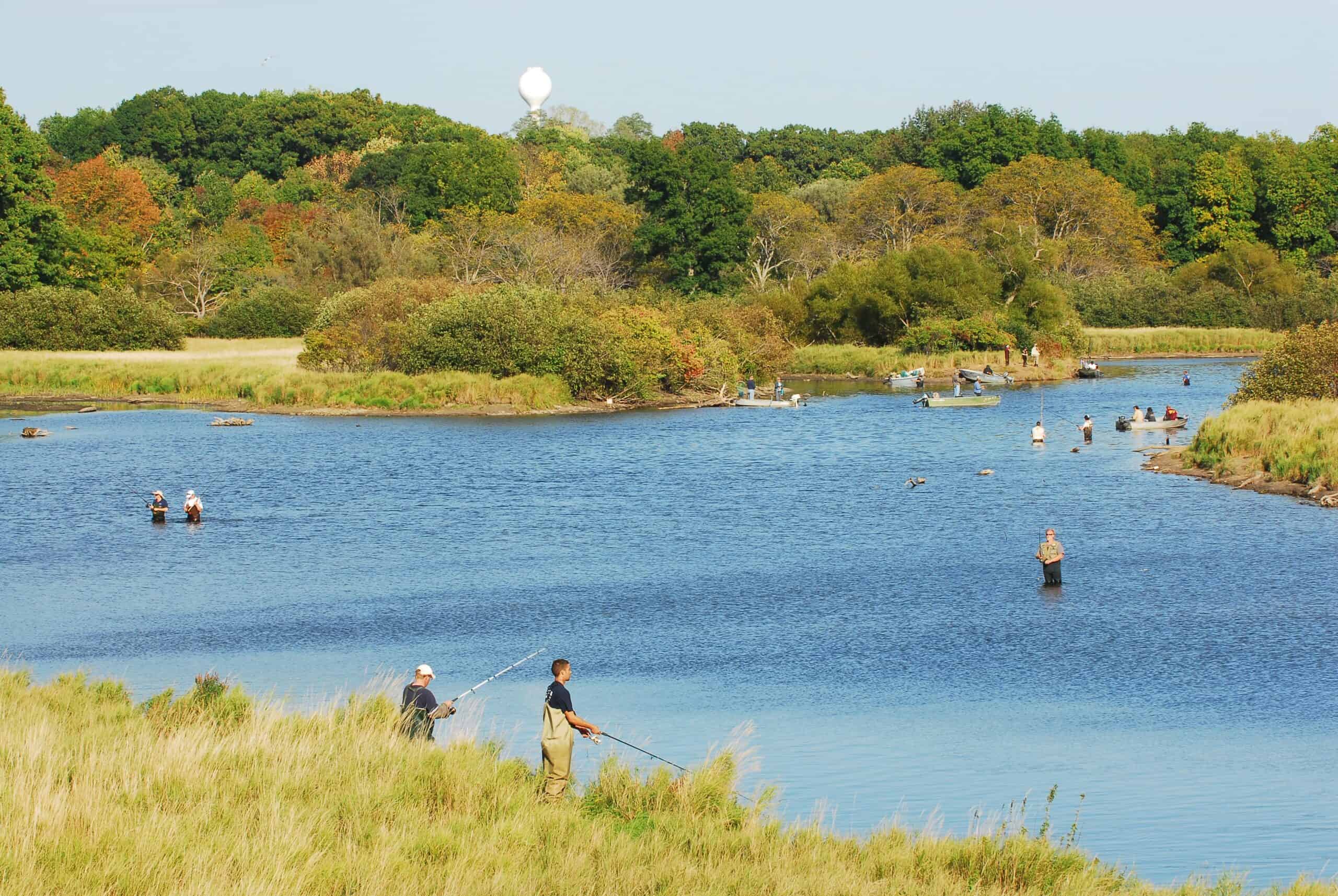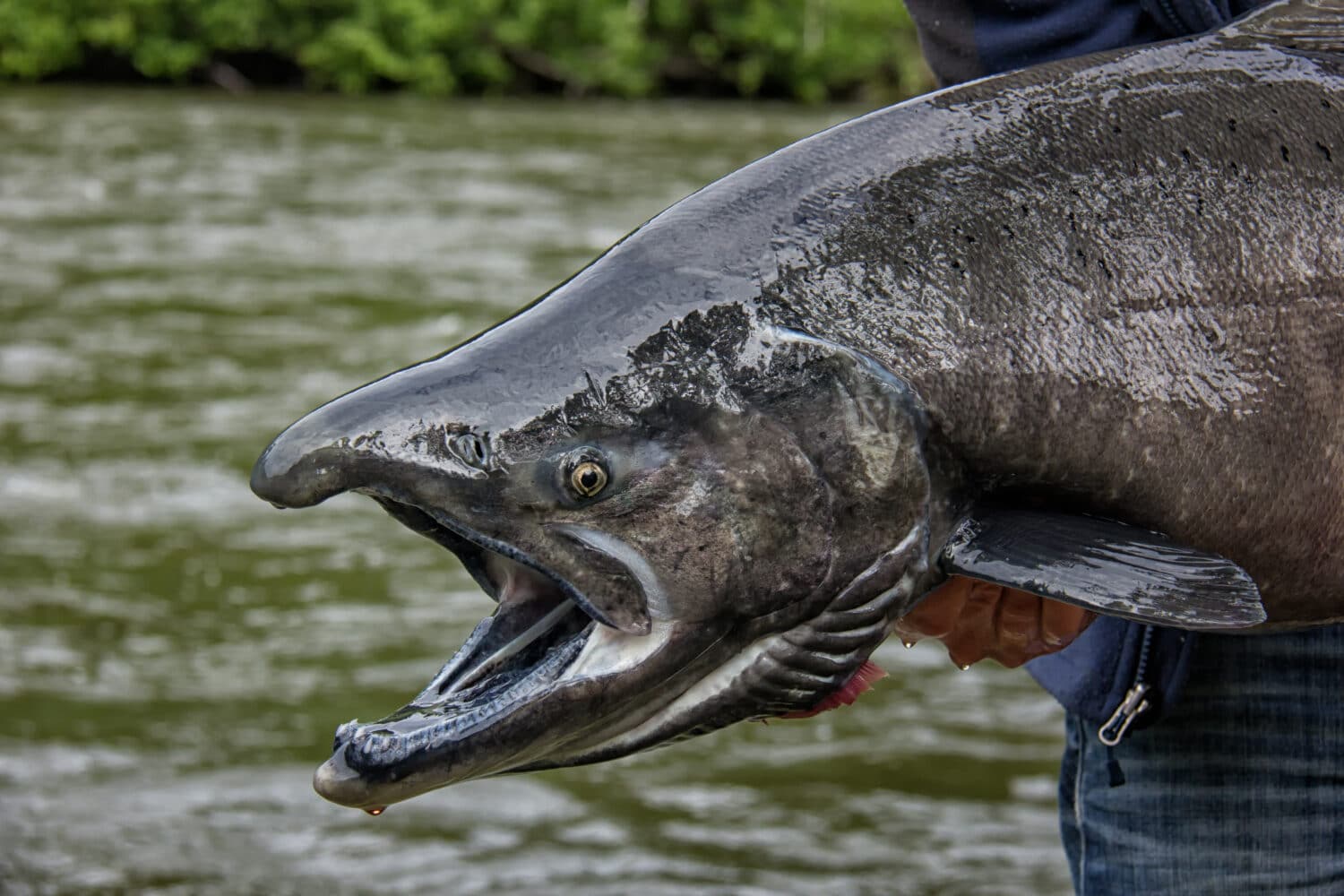
Salmon is big business in the United States. The nation’s salmon industry is worth over $3 billion annually and includes both farm-raised and wild-caught fish. Along with commercial fishing, salmon are favorites among recreational anglers due to their size and power, as well as their reputation as outstanding table fare.
According to OceanBox, salmon is the most-eaten fish in the U.S. and the second most-eaten seafood overall, trailing only shrimp. (If you prefer shrimp over salmon, here are 30 easy shrimp ideas for weeknight dinners.) Salmon can be prepared in any number of ways. It can be grilled, roasted, baked, poached, smoked, and pickled. Not only is salmon delicious, but it is also among the healthiest fish to eat. These fish are high in protein and omega-3 fatty acids. Salmon also have significantly lower mercury levels than most other fish species. It’s no surprise that these fish are favored by millions of anglers and epicures, alike.
There are six salmon species native to the United States, five from the Pacific and one from the Atlantic. Here is a look at the largest of each salmon species ever caught in the U.S., including one very rare hybrid of two salmon species. There are some true monsters on this list, including the largest individual salmon ever caught in the U.S. That fish weighed as much as a full-grown Rottweiler!
24/7 Wall St. compiled this list of the largest salmon caught in the U.S. by consulting official state fishing records. World records were corroborated by the International Game Fish Association (IGFA). Widely recognized as sport fishing’s governing body, IGFA verifies and documents world fishing records. Each of the following U.S. records is also a world record unless otherwise noted.
Pink Salmon
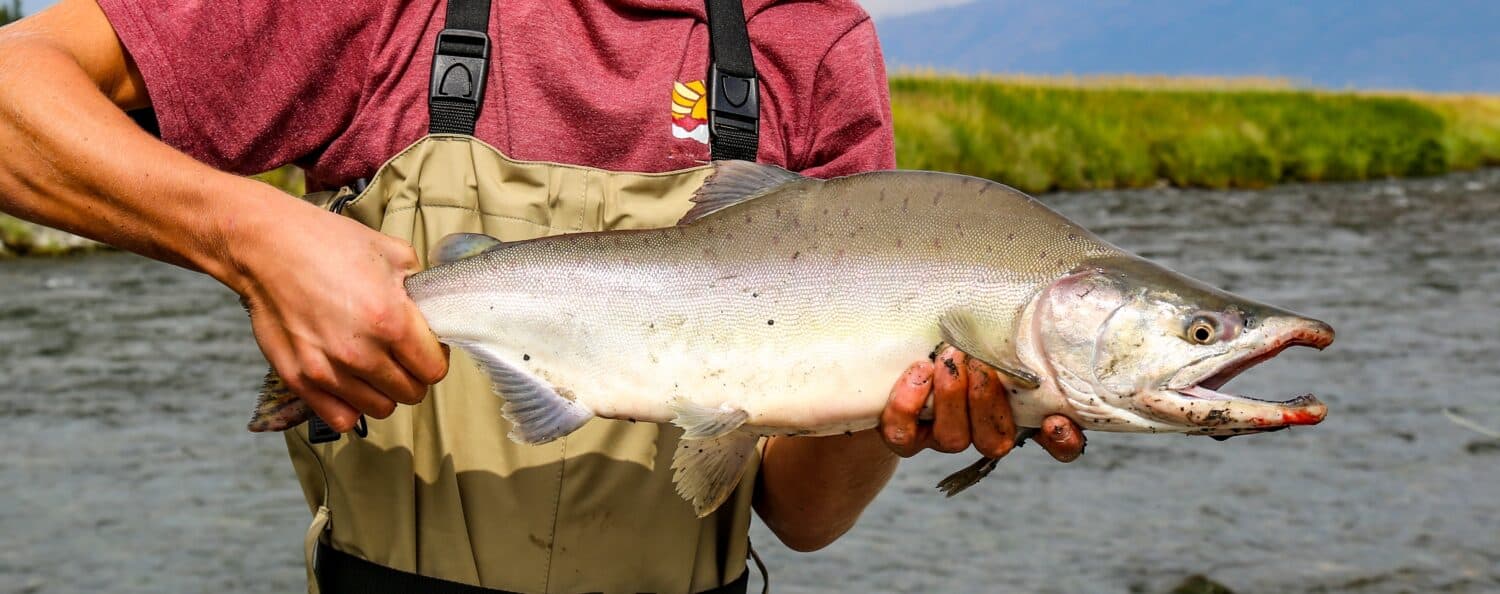
- Weight: 14 pounds, 13 ounces
- Angler: Alexander Minerich
- Date: September 30, 2001
- Location: Monroe, Washington
The pink salmon (Oncorhynchus gorbuscha) is so named because of the pinkish color of its flesh. It is also known as the humpback salmon due to the pronounced humpback males develop before they spawn.
This salmon is the smallest of any salmon species in the U.S. Mature pink salmon typically weigh from 3.5 to 5 pounds. It is also the most abundant of all the salmon species. Pinks are native to U.S. waters stretching from Alaska to Puget Sound in Washington State. Pink salmon were accidentally introduced in Lake Superior in 1956. Since then, pinks have spread to all five of the Great Lakes.
Most commercial pink salmon is canned. The vacuum tubes used to unload commercial fishing boats often harm the naturally tender flesh of pink salmon, so canning is the best option. Recreational anglers, however, can enjoy a wonderfully tender fillet from pink salmon.
Sockeye Salmon
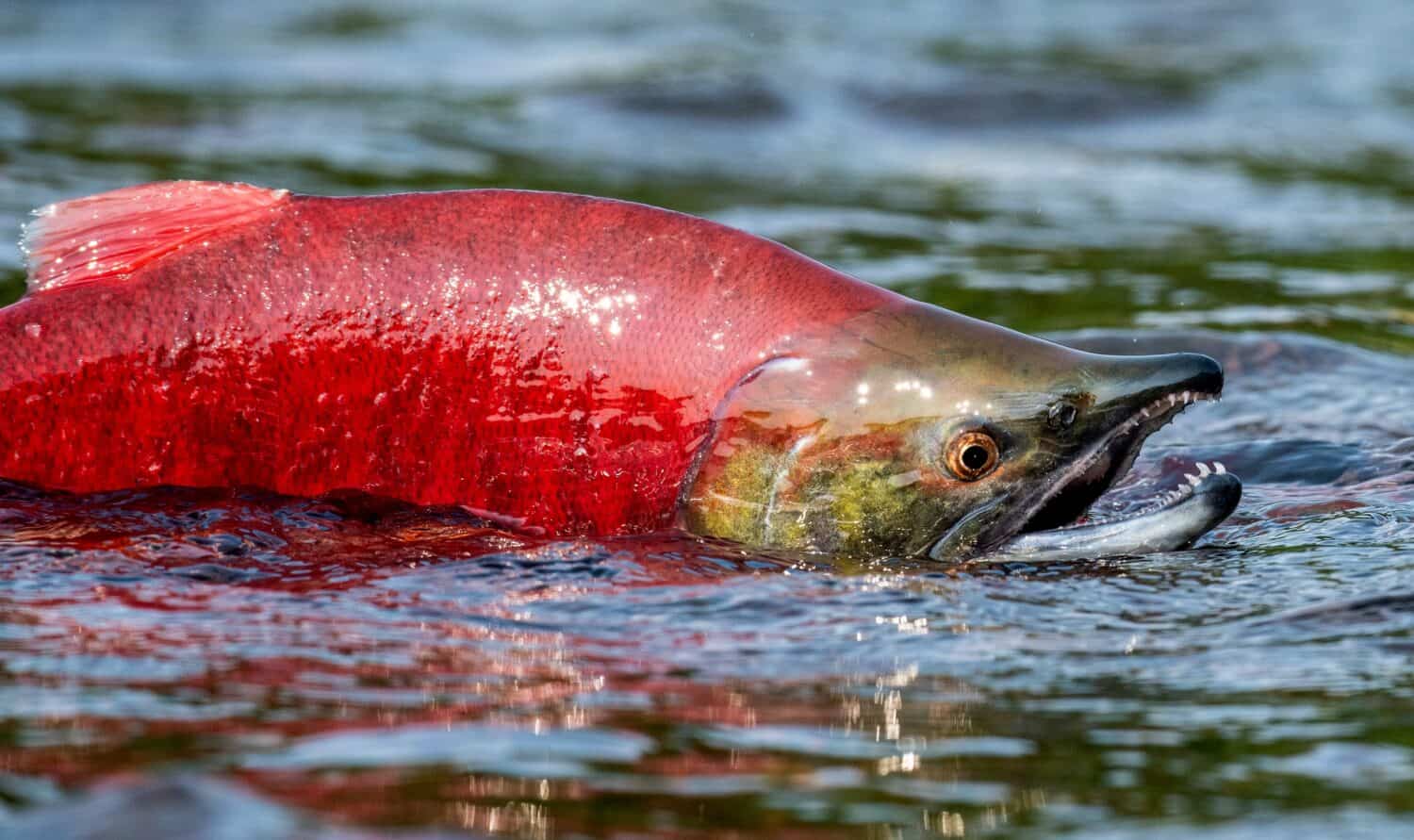
- Weight: 15 pounds, 3 ounces
- Angler: Stan Roach
- Date: August 9, 1987
- Location: Kenai River, Alaska
Alaska is the best state for salmon fishing in the U.S. and it’s not remotely close. All other states find themselves competing for second place. Alaska’s Kenai River is often regarded as the best salmon fishery in the nation. Three of Alaska’s five salmon state records have come from this river. The Kenai also produced two world-record salmon catches, one of which was a massive sockeye caught in 1987.
Sockeye salmon (Oncorhynchus nerka) are also known as blueback salmon, red salmon, and redfish. These Pacific salmon are native to U.S. waters stretching from Northwest Alaska to the Deschutes River in Oregon.
The kokanee salmon is the non-anadromous (landlocked) form of sockeye salmon. Kokanees are native to U.S. lakes in Alaska, Washington, Oregon, California, and Idaho. They are also found in British Columbia and the Yukon in Canada.
Mature Pacific sockeyes typically weigh from 3 to 8 pounds. Anadromous (non-landlocked) sockeye salmon are silver with a white belly and green-blue back (hence the “blueback” name) while at sea. However, when the fish move into freshwater to spawn, their heads turn green and their bodies turn bright red (hence the names “red salmon” and “redfish”). Spawning males develop humped backs and hooked jaws with visible teeth.
Chum Salmon
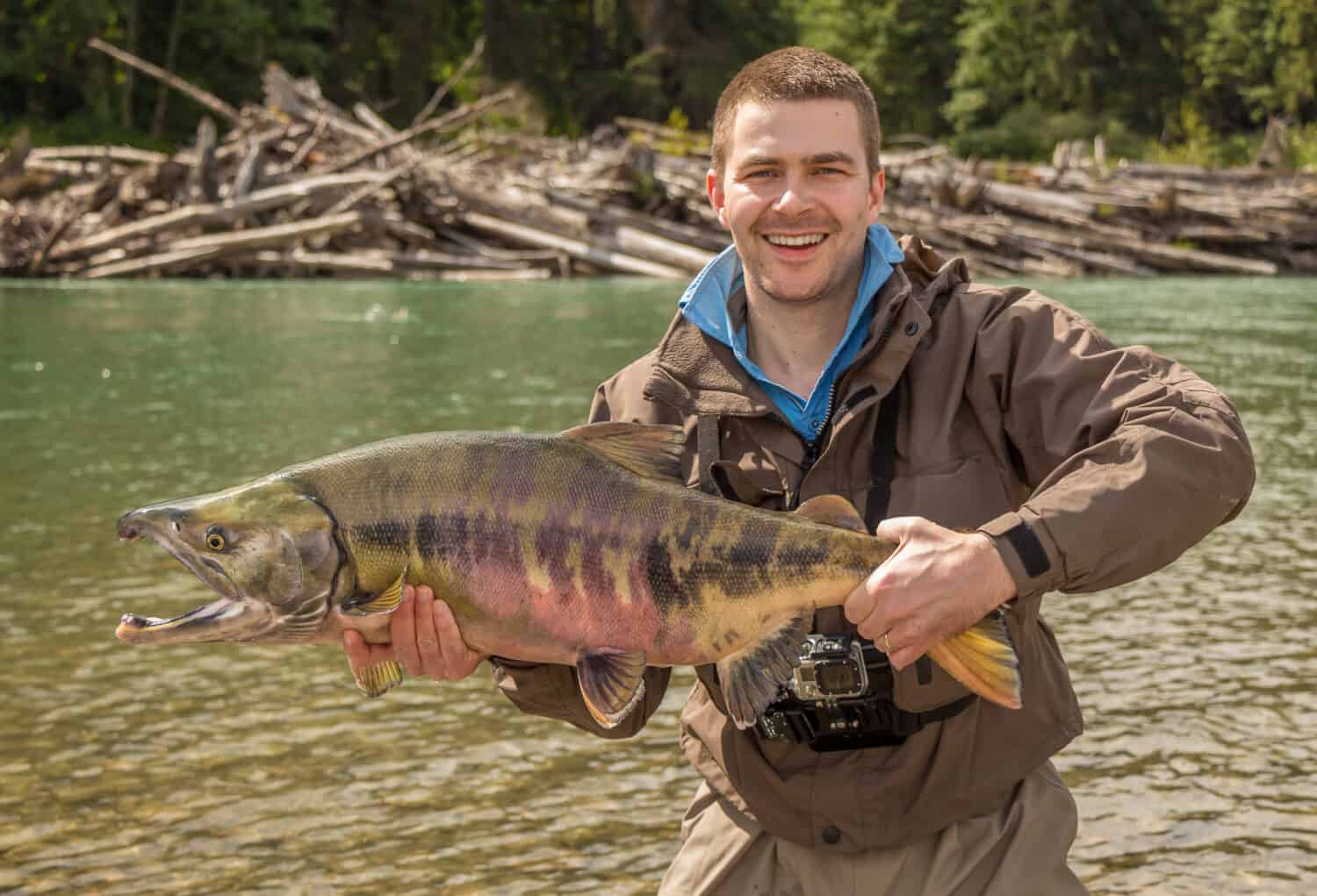
- Weight: 25.26 pounds
- Angler: Fred Dockendorf
- Date: August 7, 2001
- Location: Pacific Ocean, Grays Harbor County, Washington
The chum salmon (Oncorhynchus keta) is arguably the least-known U.S. salmon species. Historically, these salmon may have been the most numerous of all Pacific salmon species. However, factors such as overfishing and habitat degradation have led to a startling decline in chum salmon numbers. Two populations of chum salmon have been classified as “threatened” under the Endangered Species Act.
Chum salmon are also known as dog salmon, keta salmon, and calico salmon. While at sea, chum salmon feature silver sides and a greenish-blue back, similar to sockeye salmon. When the fish move to freshwater to spawn, both males and females develop pronounced red and black stripes. Males grow imposing canine-like fangs, hence the name “dog salmon.” Male chums also develop a bright calico pattern, marked with bold red and black lines, which gave rise to the name, “calico salmon.”
Adult chum salmon typically weigh between 6 and 15 pounds. They are the most widely distributed of all the Pacific salmons. The fish’s U.S. range includes all of Alaska’s coastal waters and stretches south to Yaquina Bay in Oregon.
The largest chum salmon ever caught in the U.S. came from Grays Harbor County in Washington State. While that fish was a beast, it was still almost ten pounds shy of the world record. The largest chum salmon on record weighed a jaw-dropping 35 pounds. It was caught on July 11, 1995, in British Columbia, Canada.
Atlantic Salmon
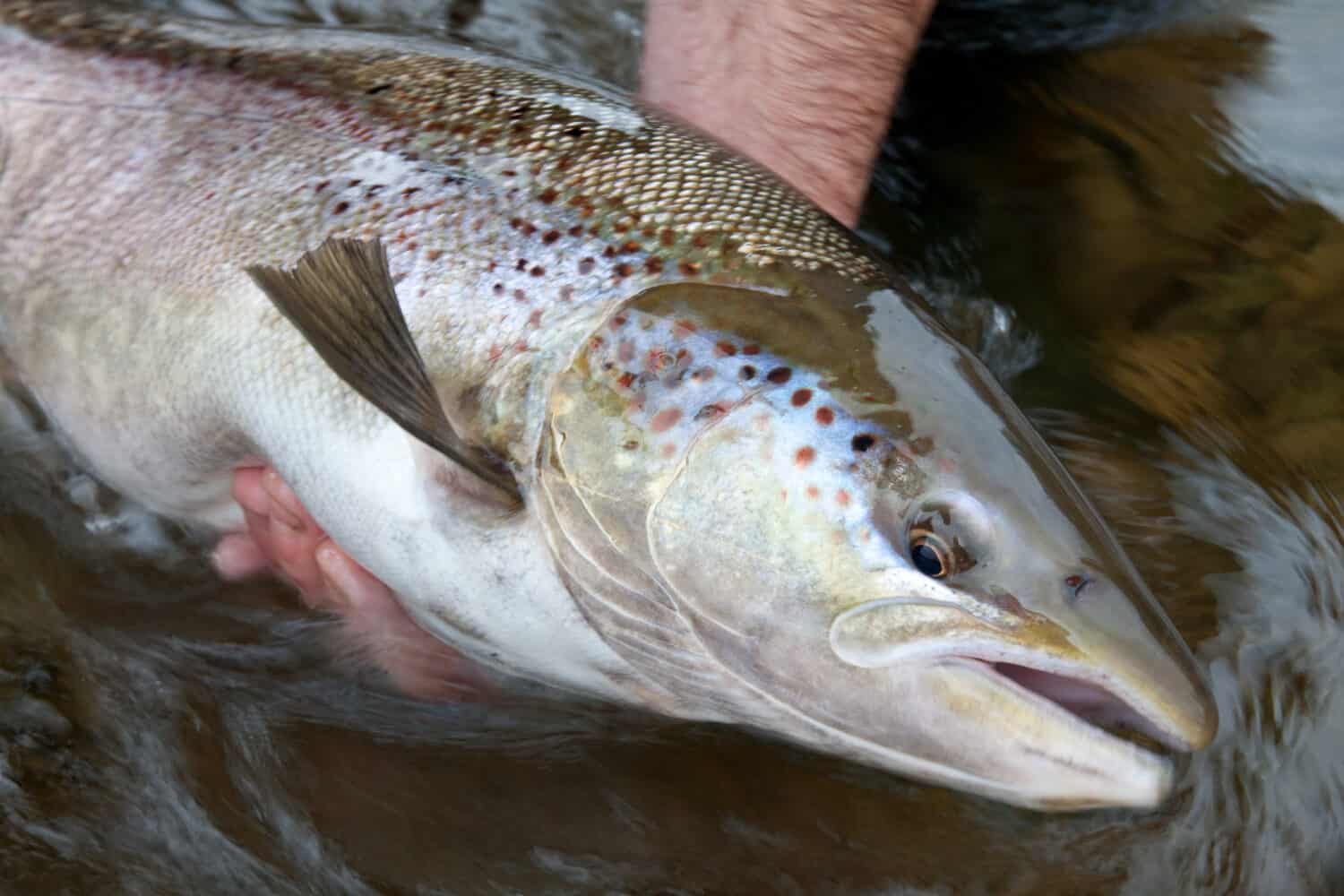
- Weight: 32.62 pounds
- Angler: Elaine G. Bender
- Date: 1981
- Location: Lake Michigan, Mason County, Michigan
The Atlantic salmon (Salmo salar) is the only salmon species native to the Atlantic Ocean. There are three groups of wild Atlantic salmon: the North American, European, and Baltic groups. The North American group’s range stretches from northern Quebec to Long Island Sound.
Atlantic salmon once proliferated the coasts and rivers of the Northeast U.S. However, due to overfishing, dam construction, and other factors, the population has been decimated. Maine is now the only state with a native Atlantic salmon population. The Gulf of Maine’s Atlantic salmon are protected under the Endangered Species Act.
Commercial fishing for Atlantic salmon was closed in 1948. Recreational fishing for wild sea-run Atlantic salmon is also prohibited. As such, no U.S. states list sea-run Atlantic salmon fishing records. There are, however, records for landlocked Atlantic salmon.
All salmon species are anadromous, meaning they can survive in both saltwater and freshwater. Atlantic salmon have been introduced in the Great Lakes as well as other select U.S. lakes.
The Atlantic salmon is silver while at sea, but turns to a bronze color when the fish moves to its freshwater spawning grounds. Its color darkens even further after spawning, leading to one of the fish’s other names, the “black salmon.” The silver color returns once the Atlantic salmon swims back into the sea. Unlike all Pacific salmon species, Atlantic salmon do not die after spawning.
The largest U.S. landlocked Atlantic salmon on record was caught in Michigan in 1981. That fish weighed 32.62 pounds. An average Atlantic salmon weighs 8 to 12 pounds, so this was a real giant. However, while that fish is in Michigan’s record books, it is not recognized by IGFA even though it far outweighs the current landlocked Atlantic salmon world record.
There are any number of reasons why a fishing record might not not recognized by IGFA. The organization has specific fishing rules regarding how a world-record fish can be caught. If these rules are violated, the fish will not be considered by the organization. Anglers must also complete an intensive verification process to register a record fish with IGFA. Some anglers choose not to complete the rather lengthy process.
The world record sea-run Atlantic salmon was caught on January 1, 1928, in Norway. That fish weighed an astonishing 79 pounds, 2 ounces.
Coho Salmon
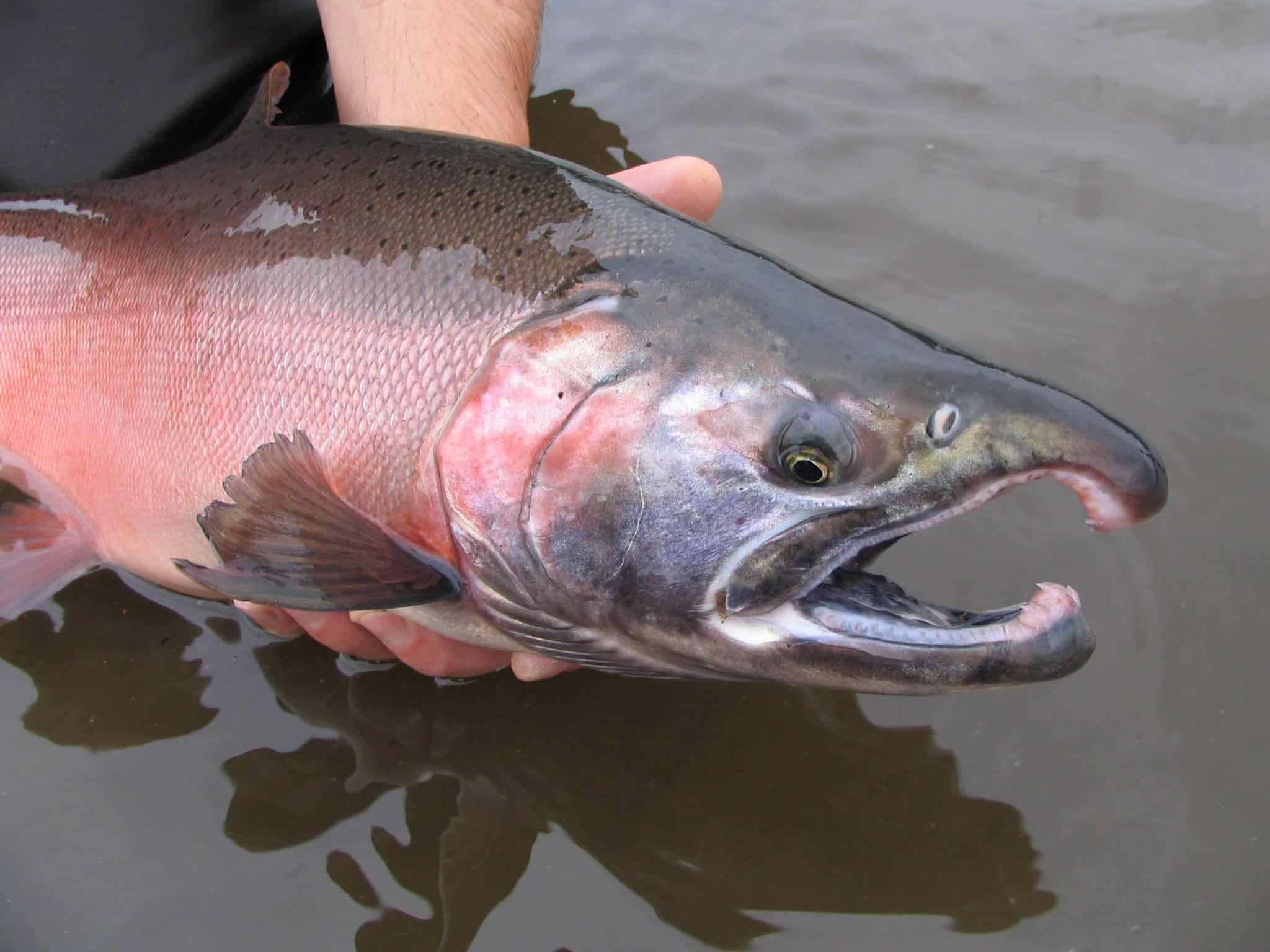
- Weight: 33 pounds 4 ounces
- Angler: Jerry Lifton
- Date: September 27, 1989
- Location: Salmon River, Pulaski, New York
The coho salmon (Oncorhynchus kisutch) is a Pacific salmon species. Its native range in U.S. waters stretches from Alaska to central California. However, the world record coho was caught in the aptly named Salmon River in New York State. Again, the salmon’s anadromous nature has allowed cohos to be stocked in freshwater fisheries far beyond its native Pacific range. Cohos have been introduced in all the Great Lakes and other freshwater environments throughout the U.S.
Coho salmon are also known as silver salmon because of their silver sides. They have a lighter-colored belly and a dark blue/green back. The fish also features black spots.
Like other salmon species, the fish changes color when it moves into freshwater to spawn. Cohos take on a reddish-maroon color when spawning, which is why some people call them medium red salmon. Male cohos also develop a kype (a strongly hooked snout) and large teeth when spawning.
A mature coho normally weighs from 8 to 12 pounds. Cohos are among the most popular game fish in the Pacific Northwest
Chinook-Coho Salmon
- Weight: 35 pounds 8 ounces
- Angler: Brooks Gerli
- Date: October 21, 2001
- Location: Salmon River, Pulaski, New York
This hybrid salmon is a rarity, but sometimes Chinook and coho salmon do crossbreed. Chinook-coho salmon (Oncorhynchus tshawytscha x O. kisutch) are most often found in Lake Ontario and its tributaries, such as the Salmon River where the world record hybrid was caught.
It is unknown how many of these hybrid fish are caught each year because many anglers misidentify them as coho salmon. Researchers can positively identify the hybrid by examining the pyloric caeca in the fish’s post-gastric intestinal tract.
Chinook Salmon

- Weight: 97 pounds, 4 ounces
- Angler: Les Anderson
- Date: May 17, 1985
- Location: Kenai River, Alaska
The Chinook salmon (Oncorhynchus tshawytscha) is the largest salmon species in the U.S. This is why it is also known as the king salmon. Other names for this salmon include spring salmon, Tyee salmon, Quinnat salmon, and blackmouth.
Chinook salmon are named for the indigenous Chinookan peoples of the Pacific Northwest. The fish’s native U.S. range runs from the Monterey Bay area of California to the Chukchi Sea area of Alaska.
In 1967, Chinook and other salmon species were introduced into Lake Michigan and Lake Huron to control the population of the invasive alewife. These fish did, indeed, feast on alewives, so they were introduced into the other Great Lakes, as well. Chinooks have also been introduced into other U.S. freshwater fisheries.
Like other Pacific salmon, Chinooks have silver sides with a blue-green back and white belly. They also feature dark pigment around the gumline, hence the colloquial name, “blackmouth.” When the fish spawn in freshwater, they turn to an olive-brown, reddish, or purplish color.
A mature Chinook salmon can weigh from 10 to 30 pounds, but individual fish can weigh well over 100 pounds. The largest Chinook caught via any method was captured in a fish trap in the Kenai River in Alaska in 1949. That fish weigh an astonishing 126 pounds! Fish traps are not a recognized fishing method by IGFA. The official world record Chinook caught by a recreational angler weighed 97 pounds, 4 ounces. It was also pulled from the Kenai River in Alaska. As noted earlier, the Kenai is a salmon angler’s utopia.
The Average American Has No Idea How Much Money You Can Make Today (Sponsor)
The last few years made people forget how much banks and CD’s can pay. Meanwhile, interest rates have spiked and many can afford to pay you much more, but most are keeping yields low and hoping you won’t notice.
But there is good news. To win qualified customers, some accounts are paying almost 10x the national average! That’s an incredible way to keep your money safe and earn more at the same time. Our top pick for high yield savings accounts includes other benefits as well. You can earn up to 3.80% with a Checking & Savings Account today Sign up and get up to $300 with direct deposit. No account fees. FDIC Insured.
Click here to see how much more you could be earning on your savings today. It takes just a few minutes to open an account to make your money work for you.
Our top pick for high yield savings accounts includes other benefits as well. You can earn up to 4.00% with a Checking & Savings Account from Sofi. Sign up and get up to $300 with direct deposit. No account fees. FDIC Insured.
Thank you for reading! Have some feedback for us?
Contact the 24/7 Wall St. editorial team.
